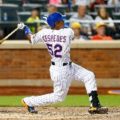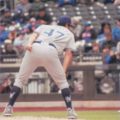By Christopher Saunders
The Northeast usually isn’t known for high end baseball talent — Mike Trout being one of the notable exception — otherwise basketball and football predominate. Things might be changing very soon namely at the University of Connecticut, where baseball has produced a lot of major league talent.
UConn has become a hot prospect pipeline in the Northeast, headlined by George Springer, Nick Ahmed and Matt Barnes just to name a few. Anthony Kay can now join that list as the second of the Mets’ first-round picks in the 2016 Draft. As a junior at UConn, Kay went 9-2 with a 2.65 ERA, 111 strikeouts and 37 walks over 119 innings.
Former teammate and Bridgeport Bluefish catcher Connor David had nothing but praise for Kay.
“He was a competitor on the mound and a smart one at that. He wouldn’t give in no matter the count or situation in the game.” David said. He’d go one later to say, “The transition from a competitor, to a smart competitor, to someone who understands the game really is what helped him grow as a pitcher.”
The 6-foot, 190-pound Long Island native is the Huskies’ all-time leader with 263 strikeouts in three seasons.. The track record that Kay made for himself led to his first round status, however, the left-hander signed for a below-pick value bonus of $1.1 million when his physical raised concerns about his elbow.
Those concerns eventually led to Kay undergoing Tommy John surgery in October which means he will miss the entire 2017 season, the team announced. Interesting to note that Kay did not pitch after the Mets drafted him in June out of the University of Connecticut and gave him a below pick money.
The 21-year-old was dealing with concerns about his elbow at the time of the Draft and it was a matter of when not “if” the ligament would fail.
When healthy Kay is the prototypical pitchability lefty, one with a track record of success at UConn as well as in the Cape Cod League in 2014 and with Team USA in 2015. He’s a strike-thrower who keeps hitters guessing, though he does so without a true out pitch. He can touch 94-95 mph with his fastball, sitting effectively at around 91 mph.
His changeup is his best secondary offering, having above-average control with late sink and depth. The only drawback and something he’ll have to correct once he’s fully healthy is stop lowering his arm slot when he throws it.
The breaking ball is fringy at best and will become a key third pitch that could determine the kind of ceiling he’ll have. Evaluators see Kay as a poor man’s Mark Buehrle, one who would do well to add a cutter to his repertoire. He could be the kind of college lefty, once he returns to health, who ascends to the big leagues quickly as a mid-to-back end starter.
Comments: Twitter @_SmokeSaunders, Facebook Chris Saunders, Instagram _smokesaunders, Email Chrisweather16@yahoo.com

















Follow Us